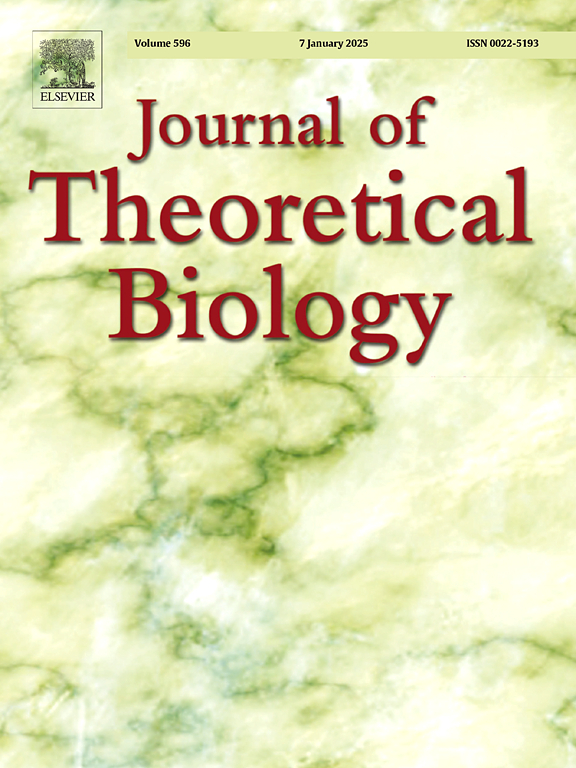有界环境随机性产生次级Allee阈值。
IF 2
4区 数学
Q2 BIOLOGY
引用次数: 0
摘要
当一个种群低于一定的临界密度时,它就会灭绝,高于一定密度时,它就会继续存在。具有环境随机性的经典模型预测了不可避免的灭绝,其产生的假设是环境变化是正态分布的,具有罕见但任意的大效应量。然而,环境波动是有界的,往往不是正态分布的。为了解决这一现实,我分析了经历Allee效应的种群的分段确定性马尔可夫模型(PDMPs),其中环境动力学由有限状态马尔可夫链控制。这些模型预测种群可以通过出现两个阈值密度而持续存在。低于最低阈值,种群必然会灭绝;高于更高的阈值,它们肯定会持续存在。在中等密度下,种群经历随机双稳定性:具有正的互补概率,它们要么灭绝,要么存活。当一种环境的承载能力低于另一种环境的Allee阈值时,持久性就变得不可能。只有当环境状态非单调地影响人均增长率时,这种不匹配才会发生,因为当环境支持更高的承载能力时,也会产生更高的捕食水平或更大的配偶限制。这项工作表明,结合现实的有限环境波动大大改变了对人口持久性的预测,对保护和管理具有重要意义。本文章由计算机程序翻译,如有差异,请以英文原文为准。
Bounded environmental stochasticity generates secondary Allee thresholds
A population exhibits an Allee effect when there is a critical density below which it goes extinct and above which it persists. Classical models with environmental stochasticity predict inevitable extinction, stemming from the assumption that environmental variation is normally distributed with rare but arbitrary large effect sizes. However, environmental fluctuations are bounded and often not normally distributed. To address this reality, I analyze piecewise deterministic Markov models (PDMPs) of populations experiencing Allee effects, where environmental dynamics are governed by a finite-state Markov chain. These models predict that populations can persist through the emergence of two threshold densities. Below the lower threshold, populations deterministically go extinct; above the higher threshold, they deterministically persist. At intermediate densities, populations experience stochastic bistability: with positive, complementary probabilities, they either go extinct or persist. Persistence becomes impossible when the carrying capacity in one environment falls below the Allee threshold in another. Such mismatch occurs only when the environmental state affects per-capita growth rates non-monotonically, as when environments supporting higher carrying capacities also produce higher predation levels or greater mate limitation. This work demonstrates that incorporating realistic bounded environmental fluctuations substantially alters predictions about population persistence, with important implications for conservation and management.
求助全文
通过发布文献求助,成功后即可免费获取论文全文。
去求助
来源期刊
CiteScore
4.20
自引率
5.00%
发文量
218
审稿时长
51 days
期刊介绍:
The Journal of Theoretical Biology is the leading forum for theoretical perspectives that give insight into biological processes. It covers a very wide range of topics and is of interest to biologists in many areas of research, including:
• Brain and Neuroscience
• Cancer Growth and Treatment
• Cell Biology
• Developmental Biology
• Ecology
• Evolution
• Immunology,
• Infectious and non-infectious Diseases,
• Mathematical, Computational, Biophysical and Statistical Modeling
• Microbiology, Molecular Biology, and Biochemistry
• Networks and Complex Systems
• Physiology
• Pharmacodynamics
• Animal Behavior and Game Theory
Acceptable papers are those that bear significant importance on the biology per se being presented, and not on the mathematical analysis. Papers that include some data or experimental material bearing on theory will be considered, including those that contain comparative study, statistical data analysis, mathematical proof, computer simulations, experiments, field observations, or even philosophical arguments, which are all methods to support or reject theoretical ideas. However, there should be a concerted effort to make papers intelligible to biologists in the chosen field.

 求助内容:
求助内容: 应助结果提醒方式:
应助结果提醒方式:


